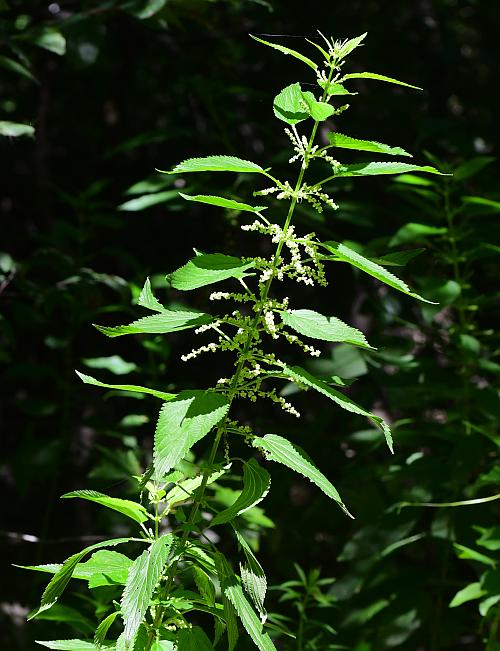Urtica dioica L.
Tall Nettle, Stinging Nettle

Native
CC = Amb
CW = 0
MOC = 43
© SRTurner
Urtica dioica L.Tall Nettle, Stinging Nettle | |
 |
Native CC = Amb CW = 0 MOC = 43 |
© SRTurner |
|
Family - Urticaceae Habit - Perennial forb, usually colonial from rhizomes, monoecious or dioecious. Stem - Ascending to erect, to 2.0 m, unbranched or less commonly branched from the base, sparsely to moderately pubescent with stinging hairs, otherwise glabrous or sparsely to densely pubescent with short, nonstinging hairs.
Leaves - Opposite, simple, petiolate, stipulate. Stipules 5-15 mm long, narrowly lanceolate. Leaf blades 4-15 cm long, the upper leaves only slightly smaller than the others at maturity, elliptic to lanceolate or narrowly to less commonly broadly ovate, rounded to truncate or shallowly cordate at the base, the margins sharply and relatively coarsely toothed, sometimes appearing doubly toothed with the main teeth having smaller teeth along their margins, the surfaces glabrous or the undersurface sparsely to moderately short-hairy, one or both surfaces sometimes also with scattered stinging hairs along the main veins, the undersurface sometimes lighter green but not purplish-tinged; cystoliths rounded.
Inflorescences - Axillary paniculate clusters with branches of spikelike racemes, mostly longer than the subtending petioles, the staminate and pistillate flowers in different inflorescences either on the same or on different plants.
Flowers - Staminate flowers with 4 sepals, these 0.8-1.5 mm long, cupped around the 4 stamens. Pistillate flowers with 4 free sepals, with 2 smaller, spreading sepals 0.8-1.2 mm long and linear to narrowly lanceolate or oblanceolate, alternating with 2 larger sepals 1.4-1.8 mm long, ovate to broadly ovate and loosely cupped around but not fused to the ovary and fruit. Style absent, the stigma capitate (papillose and appearing bushy, not persistent at fruiting), the stigmatic region linear.
Flowering - May - October. Habitat - Bottomland forests, streambanks, sloughs, bases of bluffs, levees, ditches, railroads, roadsides, moist disturbed areas. Origin - Native to the U.S. Lookalikes - Other species of Urtica; also Laportea canadensis, Boehmeria cylindrica, Acalypha rhomboidea, A. deamii. Other info. - This is one of the few Missouri species which is more common in the northern half of the state than in the southern half. Beyond Missouri its range extends across the entire northern half of the continental U.S., as well as most of Canada. It is less common to absent in southern states. The plant is recognized by its tall stature, opposite leaves, and frilly inflorescences in the upper leaf axils. The leaf blades have a characteristic appearance occasionally referred to in other plant names (e.g., Verbena urticifolia). This species can be distinguished from most of its common lookalikes by the combination of tall stature and opposite leaves. Photographs taken on Howell Island, St. Louis County, MO, 8-2-2009, at Klondike County Park, St. Charles County, MO, 7-5-2013, and along the Katy Trail near Treloar, Warren County, MO, 8-5-2020 (SRTurner). |